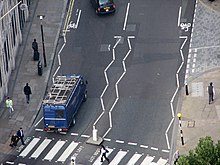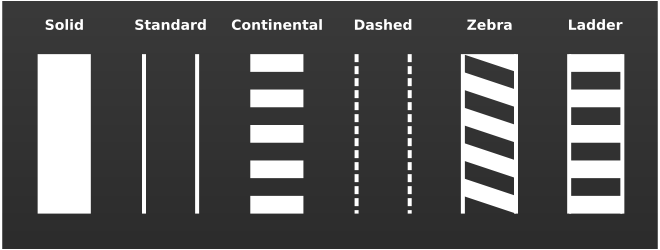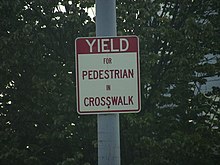Pedestrian crossing: Difference between revisions
m →In North America: sp |
No edit summary |
||
| Line 55: | Line 55: | ||
=== In other countries === |
=== In other countries === |
||
[[Image:Yield for People in Crosswalk.JPG|thumb|left|A sign warning motorists to yield to those crossing the crosswalk.]] |
|||
{{Sectstub|date=May 2008}} |
{{Sectstub|date=May 2008}} |
||
Revision as of 18:32, 30 September 2008



A pedestrian crossing or crosswalk is a designated point on a road at which some means are employed to assist pedestrians wishing to cross. They are designed to keep pedestrians together where they can be seen by motorists, and where they can cross most safely with the flow of vehicular traffic. Pedestrian crossings are often at intersections, but may also be at other points on busy roads that would otherwise be perilous to attempt to cross. They are common near schools or in other areas where there are a large number of children. Crosswalks can be considered a traffic calming technique.
Characteristics

Crossings may just consist of some markings on the pavement in low-traffic areas. However, in busier areas, they can have special signals consisting of electric lamps or light-emitting diode (LED) panels. On some traffic signals, pressing a button is required to trigger the signal. These signals may be integrated into a regular traffic light arrangement or may be on their own if the crossing is not at an intersection. Audible or tactile signals may also be included to assist people who have poor sight. Sites with extremely high traffic (freeways or motorways) may instead use pedestrian bridges or tunnels. A variation on the bridge concept, often called a skyway or skywalk, is sometimes implemented in regions that experience inclement weather. In many cities, countdown clocks are being added to give notice to both drivers and pedistrians the time remaining on the crossing signal.
Special markings are often made on the road surface, both to direct pedestrians and to prevent motorists from stopping vehicles in the way of foot traffic. There are many varieties of signal and marking layouts around the world and even within single countries. In the United States, there are many inconsistencies, although the variations are usually minor. There are several distinct types in the United Kingdom, each with their own name.
Pedestrian refuges or small islands in the middle of a street may be added when a street is very wide, as these crossings can be too long for some individuals to cross in one cycle. In places where there is very high pedestrian traffic, pedestrian scrambles (also known as Barnes Dances) may be used, which stop vehicular traffic in all directions at the same time. Another relatively widespread variation is the Curb (or kerb) extension (also known as a bulb-out) which narrows the width of the street and is used in combination with crosswalk markings.
Worldwide variations
In the Commonwealth of Nations

In the United Kingdom, animal names are used to distinguish several types of such crossings:
- Zebra crossing: wide longitudinal stripes on road, often with belisha beacons; pedestrians may cross at any time; drivers must give way to pedestrians who demonstrate intent to cross.
- Pelican crossing: traffic lights for pedestrians and vehicles; button-operated.
- Puffin crossing: pedestrian lights on near side of road; button-operated with curb-side detector.
- Toucan crossing: for bicycles as well as pedestrians.
- Pegasus crossing: an equestrian crossing.
Belisha beacons are found at zebra crossings and coloured lights at all others, often showing a pictogram of their intended user(s): a "little man", bicycle or horse.
Belisha beacons are often used in the United Kingdom, New Zealand, Singapore and Hong Kong to warn drivers of a crossing. In New Zealand, as in the United Kingdom, older signals say "CROSS/WAIT". In the United Kingdom more modern signals use pictograms instead of words.
In Australia, pictograms are standard on all traffic light controlled crossings. Like most other countries, a flashing red sequence is used prior to steady red to clear pedestrians. Moments after, a flashing yellow sequence begins for the motorist who can proceed through the crossing if safe to do so.
Other types of crossings also exist in Australia. The Zebra Crossing is common in low traffic areas. These crossings aren't usually controlled by signals. Belisha beacons are also commonly used for school crossings. Since most school crossings in the country are manned, these signals or beacons only serve as a warning to motorists.
In North America
In the United States, crosswalks are usually marked with white stripes, though every municipality seems to have a slightly different method, style, or pattern for doing so (and the styles vary over time as intersections are built and reconstructed). There are two main methods for road markings in the United States. Most frequently, they are marked with two thick white lines running from one side of the road to the other. A third "stop line", which is very thick and extends only across lanes going into the intersection, is usually also present. Left-turn stop lines are often set further back, to avoid conflict with left-turning traffic coming from the roadway on the right. The stop line acts as the legally-mandated stopping point for vehicles, and discourages drivers from stopping in the middle of the crosswalk. The other method involves the use of the more easily-visible continental stripes (like UK zebra crossings), which are becoming more popular in place of the two-line variant. The designs used vary widely between jurisdictions, and often vary even between a city and its county (or local equivalents). Where a road forms part of a city limit or other such political boundary—thus making the intersection shared between the two—there may be more than one design used on different sides, depending upon which government painted it.

Crosswalks are usually placed at traffic intersections or crossroads, but are occasionally used between intersections near schools or other popular pedestrian destination. In the United States, these so-called "mid-block" crossings may be marked by signs such as "PED XING" (for "pedestrian crossing"), by flashing yellow beacons, by stop signs, by full traffic signals, or with yellow flashing warning lights installed in the roadway called "IRWLs". In the United States, many cities are using IRWLs in conjunction with the marking methods listed above. At a crossing without a traffic signal, vehicles must yield right-of-way to a pedestrian or bicyclist who has already entered the crosswalk.
At crossings controlled by signals, the most common variety is arranged like this: At each end of a crosswalk, the poles which hold the traffic lights also have white WALK and red-orange DONT WALK signs. These particular colors are used to avoid confusion with signals for vehicles. Modern signals tend to feature an orange hand and a white pedestrian symbol instead of words. As a warning, the DONT WALK or hand signals begin to blink/flash when the transition to DONT WALK is imminent. This normally occurs several seconds before the light turns yellow, usually going solid orange when the traffic light turns yellow rather than waiting until red. Some signals continue flashing the hand/DONT WALK phase during the yellow light, and go steady at red. Sometimes the WALK signal does not come on in a steady pattern; it will sometimes blink/flash on and off instead to warn pedestrians to cross the street with caution due to the possibility of a turning vehicle. On pedestrian signals displaying text, "DONT WALK" is spelled without an apostrophe so that it fits easily on the sign. A black baffle is customarily placed in front of the lights to shield them from the sun and increase their visibility, as well as protect them from damage.
Crosswalks have also been adapted for the blind by adding two small loudspeakers at each corner. They chirp when it is safe to cross east and west, and cuckoo for north and south. The speakers are not installed at every crosswalk in a city, due to their expense, and because they generate unwanted noise pollution in quiet residential areas. These cross-walks are used quite regularly in Seattle and Portland, Oregon.
Some pedestrian signals integrate a countdown timer, showing how many seconds are remaining until the vehicular traffic will be allowed to proceed through the crosswalk, which can be found in many cities: Seattle, Washington, Washington D.C., Los Angeles, California, Orlando, Florida, Atlanta, Georgia, and Las Vegas, Nevada. Most also incorporate a button on the near side to allow a pedestrian to notify the system that a pedestrian is waiting for a WALK signal, which may or may not produce the desired signal more quickly — although some systems on busy roadways will increase motor traffic flow by not producing a WALK signal at all unless and until such a button is pushed. Generally, such buttons are most commonly used on actuated traffic signals, where a traffic signal system relies on sensors to detect vehicular traffic.
In some cities, other methods of pedestrian detection are being tested, including infrared and microwave technology, as well as weight sensors built in at curbside. On fully actuated signals, or semi-actuated traffic signals, pressing the button to cross a smaller side street will cause an "instant walk signal". Contrary to popular belief that the buttons are placebos, most buttons do work, but some only at certain times of day and even certain times of the year. In an event that the pedestrian button is malfunctioning, the pedestrian signal will be always given automatically until the button is repaired.
In California, Minnesota, and some other states and local jurisdictions, pedestrians have the right-of-way at both marked and unmarked crosswalks. Unmarked crosswalks exist at every corner in which streets approach each other at approximately right angles. See, for example, CA Vehicle Code section 275 (“Crosswalk” is...: (a) That portion of a roadway included within the prolongation or connection of the boundary lines of sidewalks at intersections where the intersecting roadways meet at approximately right angles, except the prolongation of such lines from an alley across a street.)
In most states, drivers only have to wait until the pedestrian has finished crossing the half of the crosswalk that the driver in driving on, after which the driver may proceed. In some states, such as Utah, if the driver is in a school zone with the lights flashing, the driver must wait until the entire crosswalk is clear before he may proceed. To gain the right-of-way in some parts of Canada, the pedestrian holds out his hand in a position much like that used to shake hands, and steps off the curb.
In other countries

This section needs expansion. You can help by adding to it. (May 2008) |
In some countries, instead of "DON’T WALK", "red man" or "hand" indicating when not to cross, the drawing of the person crossing appears with an X drawn over it.
In many parts of eastern Germany, the design of the crossing man (Ampelmännchen) has a hat.
In Mexico City, the walking man moves his feet.
In Taiwan the majority of crossings cannot be controlled by pedestrians, although there are exceptions in Taipei. All the crossings feature animated men who will walk faster immediately before the traffic signal will change. There is also always a countdown timer to inform the pedestrian how long they have left to cross. However, it should be noted that many motorists will largely ignore the crossing and continue driving even if pedestrians are crossing it.
Enhancements for disabled people

Pedestrian controlled crossings are sometimes provided with enhanced features to assist the disabled (disabled people). Enhancements may include:
- Tactile cones near or under the control button. These rotate and shake when the pedestrian signal is green - the image of a "green man". This is for blind or deaf pedestrians.
- Tactile surfacing pattern (or tactile paving) laid flush within the adjacent footways (US: sidewalks), so that visually impaired pedestrians can locate the control box and cone device and know when they have reached the other side. In Britain, different colours of tactile paving indicate busier crossings; yellow is a less-busy crossing, red a more major crossing.
- Audible signals, such as beeps, in order to help blind or partially-sighted pedestrians; or a short recorded message, as in Scotland, Hong Kong, Singapore and some parts of the Canada (Greater Toronto Area), the United States, including Michigan, Massachusetts and Texas. In Japan, various electronic melodies are played, often of traditional melancholic folk songs such as "Toryanse" or "Sakura". In Croatia, beeps with long intervals in-between signify "don't walk" mode and beeps with very short intervals signify "walk" mode.
- A vibrating button in addition to an audible signal is used in Australia, Germany, and some parts of the United States, Greece and Ireland to assist hearing-impaired people (see also 'cones' at the top of this list)
- Electrostatic, touch-sensitive buttons; these require no force to activate. To confirm that a request has been registered, the buttons usually emit a chirp or other sound.
Other useful information
- The Assessment of Pedestrian Crossings - Department for Transport (United Kingdom) http://www.dft.gov.uk/pgr/roads/tpm/ltnotes/theassessmentofpedestriancro4033
- The Design of Pedestrian Crossings - Department for Transport (United Kingdom) http://www.dft.gov.uk/pgr/roads/tpm/ltnotes/thedesignofpedestriancrossin4034
- Puffin Good Practice Guide, UK Dept. of Transport, 2006 http://www.dft.gov.uk/pgr/roads/tss/gpg/puffingoodpracticeguide01
- Puffin Good Practice Guide Video, UK Dept. of Transport, 2006 http://www.dft.gov.uk/pgr/roads/tss/gpg/
- The Installation of Puffin Pedestrian Crossings, UK Dept. of Transport, 2002 http://www.dft.gov.uk/162259/165240/244921/244924/TAL1-02.pdf
- Puffin Pedestrian Crossing, UK Dept. of Transport, 2001 http://www.dft.gov.uk/162259/165240/244921/244924/TAL1-01.pdf
See also
- Ampelmännchen, the little men that are commonly shown on pedestrian traffic lights at crossings in Germany.
- Tropicana - Las Vegas Boulevard intersection, an example of replacing grade level crossing with overhead walkways
- Stile
- Traffic light
